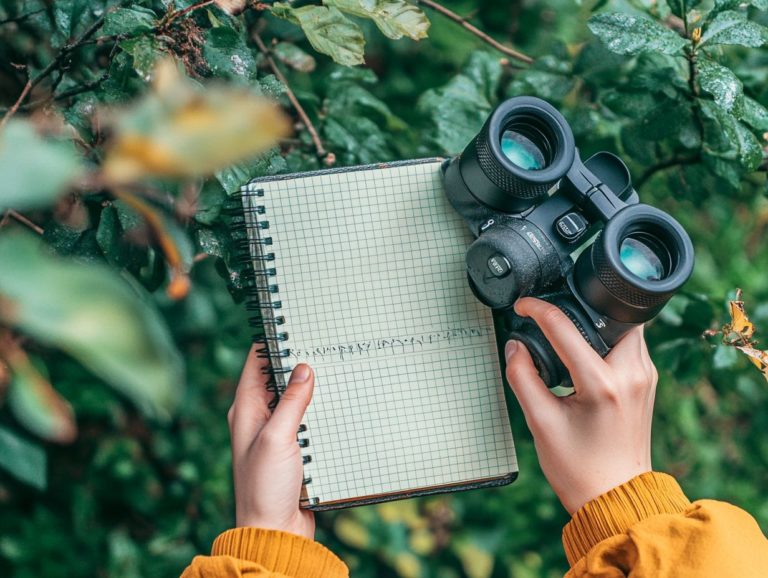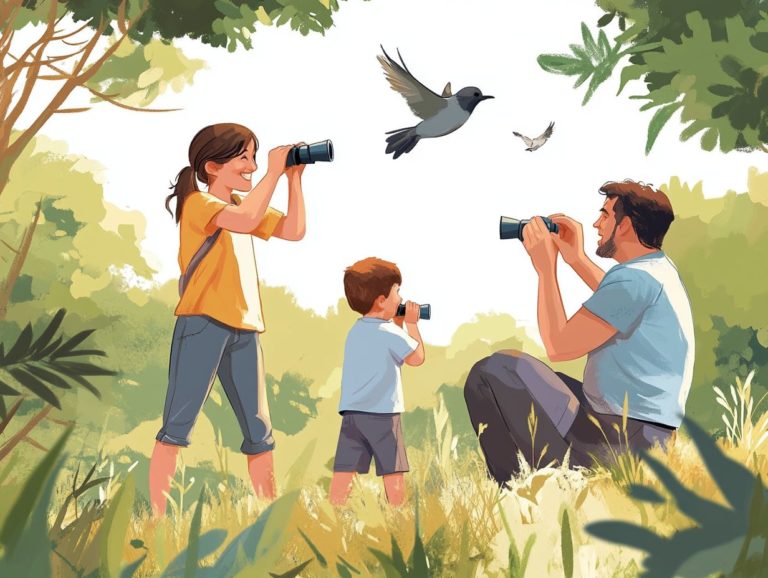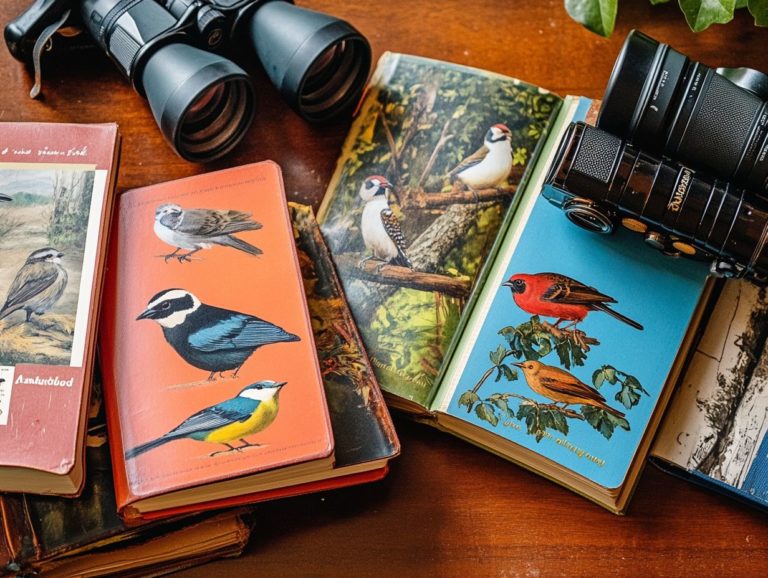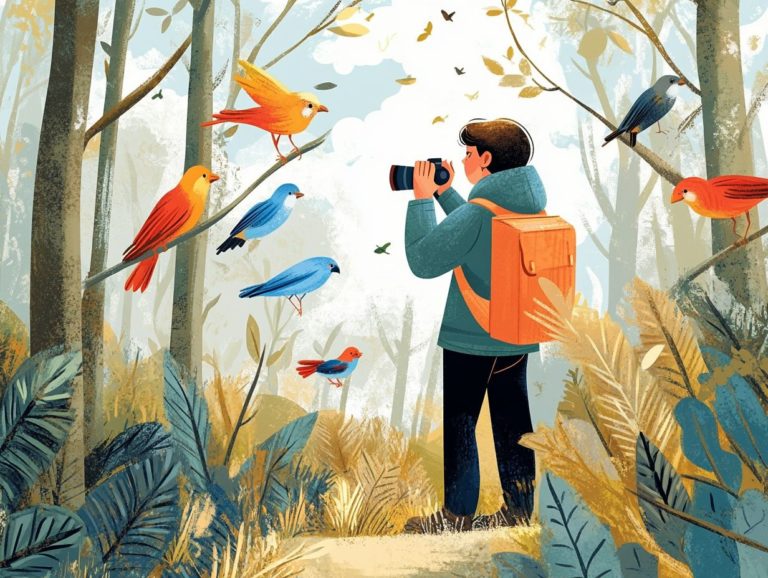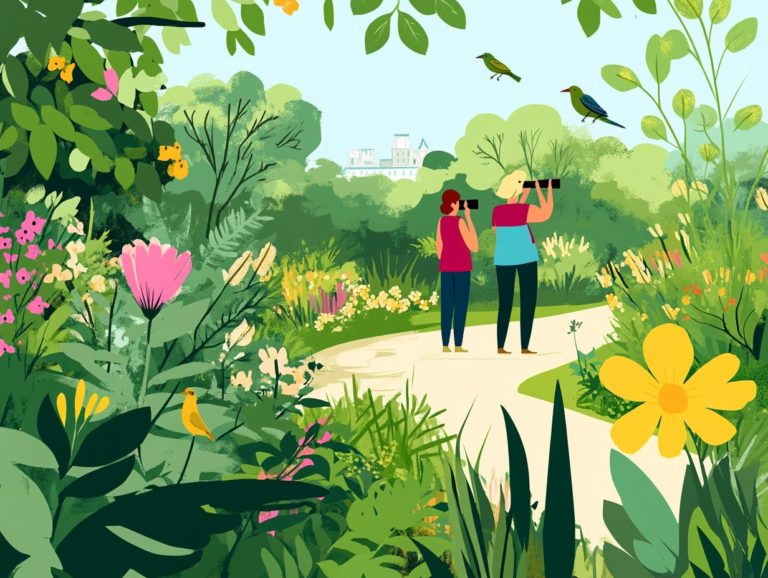How to Take Photos While Bird Watching?
Combining bird watching with photography opens up a realm of creativity and a deeper appreciation for nature, especially when exploring the art of bird photography.
In this guide, you’ll explore how to choose the right equipment, from cameras to ideal focal lengths that perfectly suit your needs. You’ll also learn about essential gear you definitely won t want to forget.
You ll uncover techniques to elevate your bird photography, including composition tips and clever strategies for photographing birds in the wild.
You will also discover the best locations for capturing breathtaking images. It’s important to prioritize safety and etiquette while exploring the wild.
Get ready to take your birding experience to the next level!
Contents
Key Takeaways:
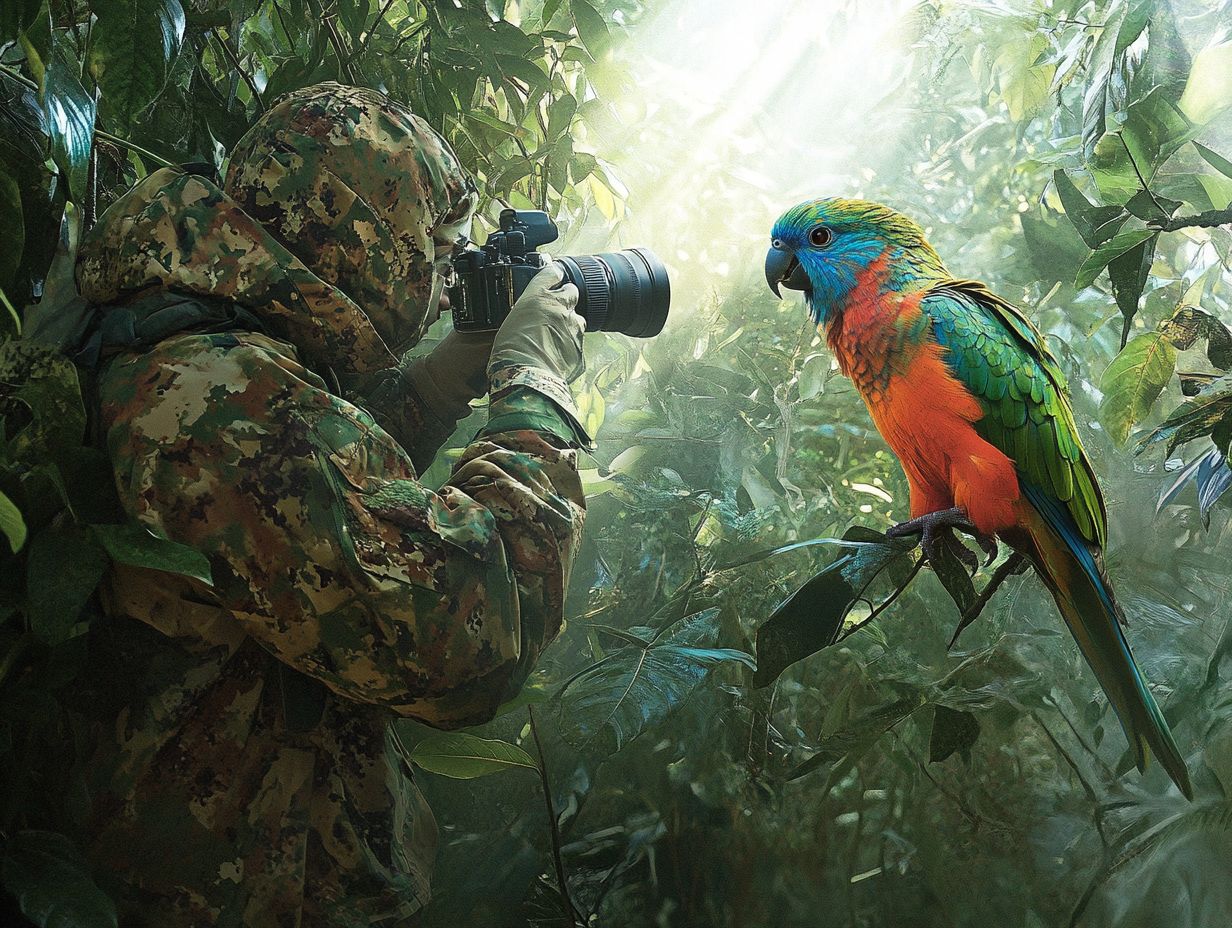
- Choose the right equipment: A camera with a telephoto lens, designed for taking pictures of distant subjects, along with essential gear like a tripod and extra batteries, will help you capture clear and detailed bird photos.
- Master techniques for bird photography: Pay attention to composition and lighting. Use strategies like camouflage and patience to get close to birds.
- Consider location and safety: Top birding hotspots offer great opportunities for photography. Always respect the birds and their habitat, and stay safe in the outdoors.
Why Combine Bird Watching and Photography?
Combining bird watching with photography presents a remarkable opportunity for you to capture the beauty of avian life while deepening your understanding of bird behavior. To enhance this experience, consider exploring how to use technology in bird watching. This harmonious blend elevates your overall experience and infuses an artistic flair into the observational practice of birding.
With bird photography, you can document your encounters, contributing valuable data to platforms like eBird. Your efforts support conservation initiatives and enrich the community of nature photographers.
By focusing on species such as the vibrant Scarlet Macaw or the elusive Snowy Owl, you can sharpen your skills in both tracking and capturing these magnificent birds on camera. The act of photographing demands patience and keen observation, encouraging you to immerse yourself more fully in your surroundings.
As you log your sightings on eBird, you not only track your personal milestones but also contribute to a broader collective database that aids researchers in understanding migratory patterns and habitat usage.
This seamless fusion of observation and art fosters a deeper appreciation for wildlife and cultivates a sense of stewardship toward our natural environments.
Gear Up for Bird Photography Success!
Selecting the right equipment is essential for any aspiring bird photographer. It directly affects the quality of the images you capture during your wildlife excursions.
Whether you lean toward a DSLR (Digital Single-Lens Reflex) camera or a mirrorless camera, which is lighter and more compact, your choice of lens such as a 500mm or 600mm can dramatically influence your ability to photograph birds in their natural habitats.
Moreover, investing in a reliable tripod system will provide enhanced stability, especially when capturing perched birds or navigating challenging lighting conditions.
This thoughtful approach will elevate your bird photography endeavors and lead to more successful outcomes.
Camera and Lens Selection
Choosing the right camera and lens for bird photography is essential for capturing stunning images that reveal the intricate details of various bird species. Utilizing techniques that enhance your photographic capabilities is key.
To excel in bird photography, consider cameras like the Canon EF 500mm f/4L or the Nikon AF-S NIKKOR 600mm f/4E. Both are renowned for their sharpness and provide clearer details in your photos. Long focal lengths are crucial, allowing you to maintain a respectful distance while still filling the frame with captivating detail. Additionally, tips for choosing binoculars for bird photography can enhance your experience. A fast autofocus system is invaluable; it enables you to swiftly track birds in flight or capture those fleeting moments of sudden movement.
When deciding between prime and zoom lenses, evaluate your shooting style. Prime lenses typically offer better low-light performance and image quality, while zoom lenses provide flexibility for varied shooting scenarios. Understanding bird behavior can also enhance your equipment choices.
By familiarizing yourself with feeding and nesting habits, you can strategically position yourself for breathtaking shots, ensuring you don t just get images, but truly remarkable ones.
Grab your gear and start exploring the world of bird photography today!
Other Essential Gear
Besides your camera and lens, several gear items can elevate your bird photography. They ensure you’re ready to seize those fleeting moments.
A sturdy tripod is vital for stability, especially with long lenses. Mastering settings like auto ISO and shutter speed helps you get the right light.
A reliable field guide will help you identify bird species, enhancing your overall experience and creating more photographic opportunities. Don’t overlook a quality set of binoculars; they assist in locating your subjects before capturing them. For more insights, consider checking best practices for bird watching. Additionally, protective gear like rain covers shields your equipment from unexpected weather changes.
Choose camera bags designed for outdoor use. They not only protect your gear but also allow quick access when perfect moments arise.
Becoming good at changing aperture settings can impact depth of field and focus. To refine your skills, consider online courses or local workshops for valuable insights.
Techniques for Capturing Bird Photos
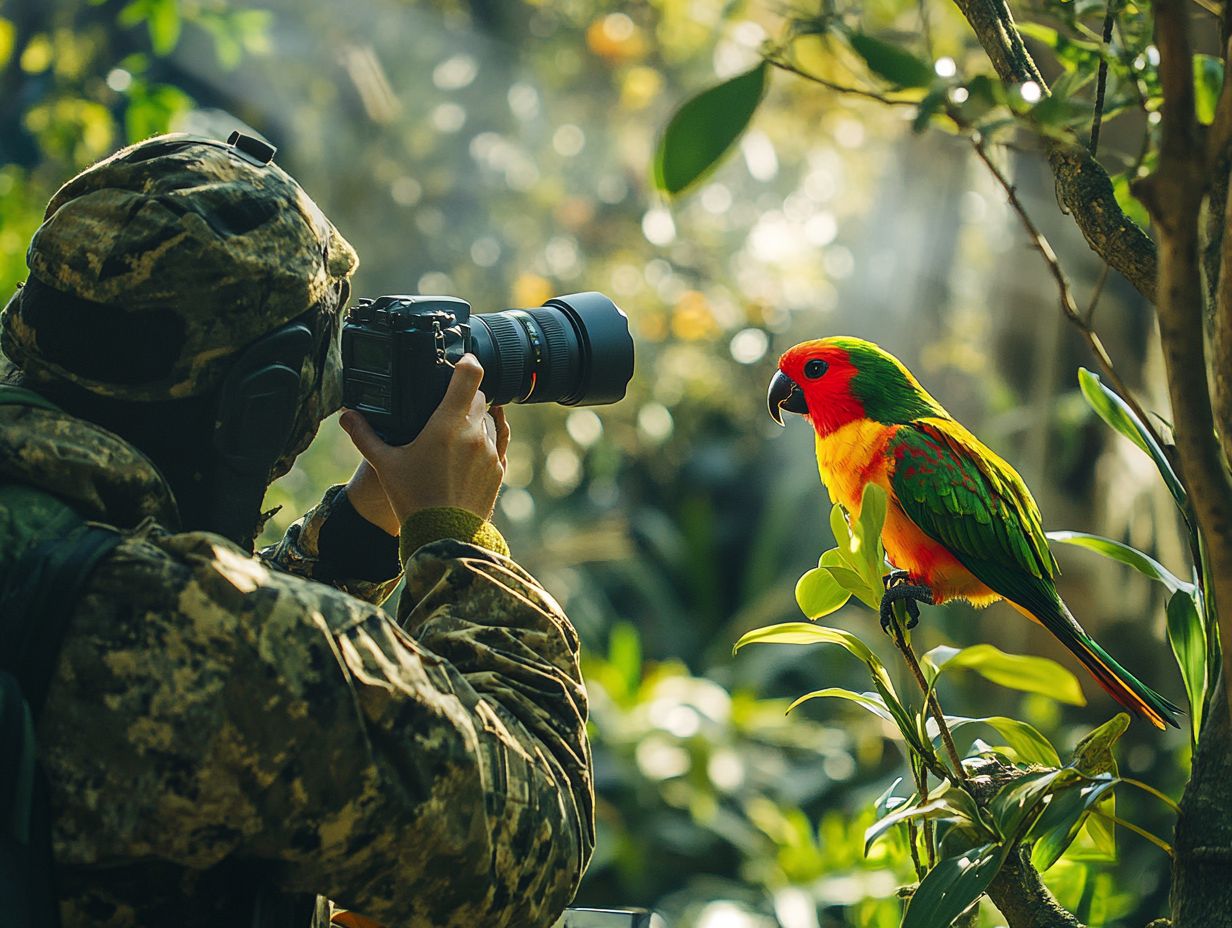
Mastering the art of capturing bird photos is essential for any wildlife photographer aiming to elevate their craft. By understanding the optimal shutter speed to freeze those fast-moving birds and employing composition techniques that accentuate the subject’s natural environment, you can significantly enhance the quality of your images. For more specialized advice, check out these tips for photographing rare bird species.
Understanding bird behavior and finding the best times to photograph them opens up opportunities for breathtaking captures, transforming every visit to birding hotspots into an unforgettable experience.
Composition and Lighting Tips
Effective composition and lighting are essential elements of bird photography that can elevate an ordinary image into something extraordinary, showcasing the beauty of avian subjects. By employing techniques like the rule of thirds or leading lines, you can craft dynamic images that capture the essence of bird behavior.
Understanding how various lighting conditions impact your photographs will enable you to choose the right time of day and position yourself for optimal effects whether basking in the golden hour or embracing the soft embrace of overcast light.
Shooting during the golden hour can create a warm, inviting glow that highlights the subtle textures of a bird’s feathers, while harsh midday sunlight might cast unflattering shadows. The interplay of light and shadow can evoke a range of emotions soft lighting often conveys a serene mood, while high-contrast light injects drama and intensity into your work.
Try experimenting with backlighting; it can lead to stunning silhouettes that showcase the bird s profile against a vibrant sky. By varying angles and exploring different environments, you can uncover unique perspectives that elevate your photography to new heights.
Strategies for Getting Close to Birds
Getting close to birds without causing a stir is both an art and a science, blending an understanding of bird behavior with effective photography strategies.
By observing their routines and grasping their habitat preferences, you can significantly improve your chances of encountering a diverse array of species. It s crucial to approach with a keen awareness of the surrounding environment, paying attention to any signs that may indicate agitation from the birds. Practicing ethical wildlife photography not only safeguards these creatures but also supports the preservation of their natural habitats.
When you find yourself at popular birding hotspots, consider the early morning or late afternoon hours for the best lighting and activity levels. This approach allows for a rewarding experience while ensuring the safety of the birds remains a top priority.
Best Locations for Bird Photography
Finding the best spots for bird photography boosts your chances of taking amazing photos. These adventures can leave you with unforgettable memories!
Popular birding hotspots are rich in bird species, making them ideal for both novice and experienced photographers.
Resources like the eBird website can help you discover local hotspots and seasonal birding locations. This allows you to plan your outings effectively while enjoying the beauty of nature.
Top Birding Hotspots
Some of the world s top birding hotspots are known for their rich ecosystems and abundant bird populations. From coastal wetlands to towering mountains, these locations offer unique opportunities to capture stunning photos of both resident and migratory birds.
By using platforms like eBird, you can pinpoint specific hotspots and get valuable information about the birds that live in these areas throughout the year.
Among these gems, the Everglades in Florida is a must-visit destination. Here, you can see the striking Roseate Spoonbill and the elegant Great Egret, especially vibrant during the spring migration.
Meanwhile, the lush rainforests of Costa Rica are filled with colorful birds like the Resplendent Quetzal. The ideal time to visit is during the dry season from December to April.
In contrast, the tundra of Alaska attracts many birdwatchers in the summer, particularly for a chance to see the elusive Steller’s Eider.
Each of these locations not only provides incredible birding experiences but also highlights the importance of timing and seasonal changes in bird behavior.
Factors to Consider When Choosing a Location
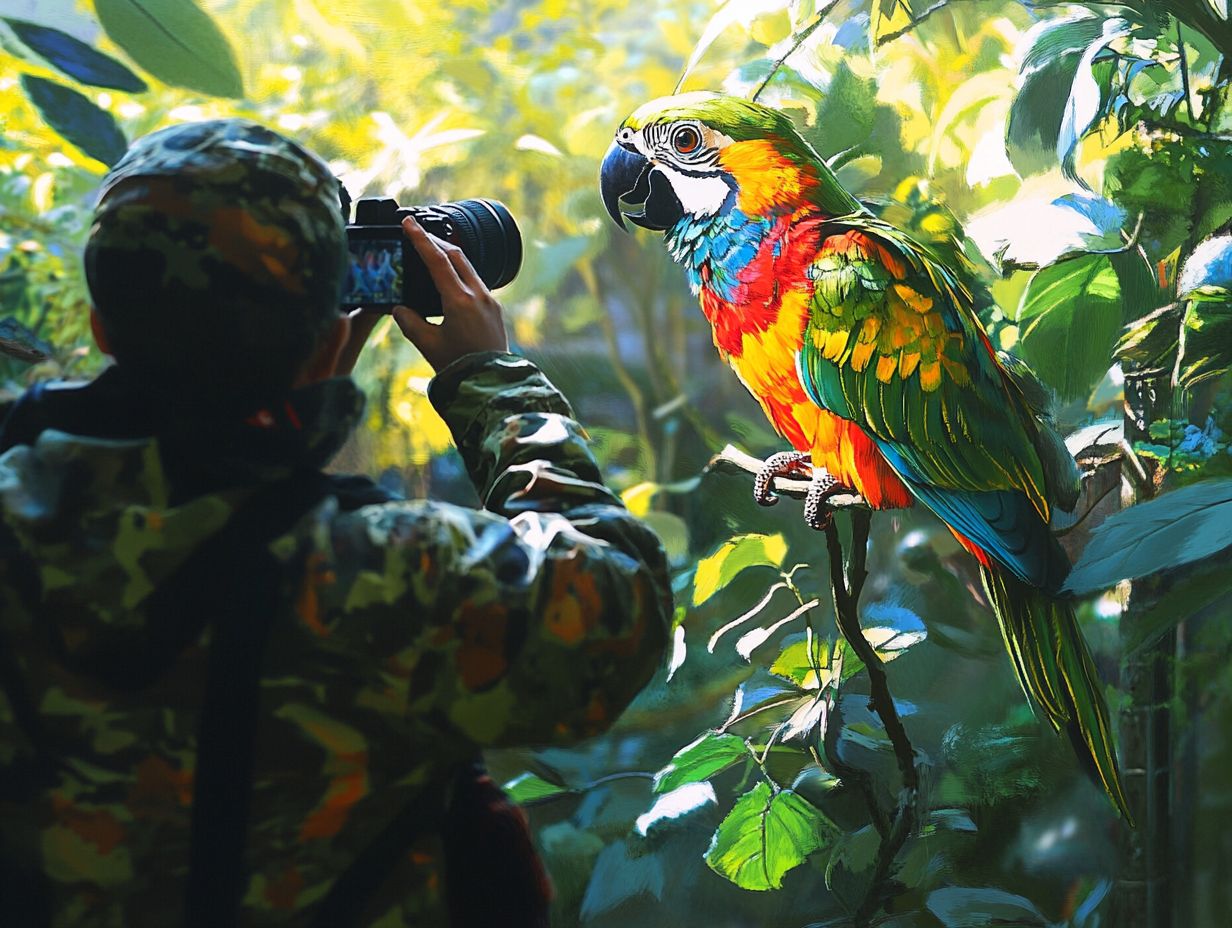
When selecting a location for bird photography, consider key factors that can greatly improve your chances of taking amazing photos. Think about elements like the time of year, specific habitat types, and the presence of water sources, as these can affect the variety of birds you might see.
Tools like the eBird website provide insights into recent sightings and seasonal trends, helping you find locations bustling with bird activity.
Also, keep logistics in mind, such as accessibility and potential crowding at popular spots. While remote areas might offer unique opportunities, they require careful planning for transport and safety.
Being flexible in your schedule allows you to make last-minute changes based on weather conditions or bird migration patterns, often leading to delightful surprises.
By adopting a thorough approach that emphasizes research and adaptability, you can enhance your experience and enrich your portfolio with stunning bird images.
Safety and Etiquette in Bird Watching
Understanding safety and etiquette in bird watching is important for your well-being and that of the birds. This helps create a harmonious environment for everyone involved.
By following guidelines while photographing birds, you engage in ethical practices and build a respectful relationship with nature. Observing local regulations, keeping a safe distance from nests and sensitive species, and minimizing disturbances can enhance your experience as a nature photographer and benefit the wildlife you aim to capture.
Bird Photography: An Overview
Respecting birds and their habitats is essential for ensuring the survival of bird species and maintaining the delicate ecosystems in which they thrive. As a bird photographer, you play a vital role in fostering awareness and conservation by adopting ethical practices during your outings.
Respecting the Birds and Their Habitat
Keep a respectful distance from nests and avoid sensitive areas during breeding seasons. Adhere to guidelines that safeguard both the birds and their natural environments.
Using long lenses allows you to capture breathtaking images without encroaching on a bird’s personal space. This approach lets them remain undisturbed so you can observe their natural behaviors.
Opt for photography in designated wildlife reserves to minimize disruption. These spaces are typically managed to protect local flora and fauna.
Engage with local conservation programs, share your stunning imagery to raise awareness, and participate in citizen science initiatives. Through these responsible actions, you elevate your practices and inspire others to appreciate and protect the remarkable diversity of birdlife and their habitats.
Staying Safe in the Outdoors
Staying safe outdoors is crucial for every bird photographer! It sets the stage for thrilling and successful adventures while minimizing risks that come with wildlife outings.
Prepare by understanding the environment, identifying potential hazards, and carrying essential gear like first aid kits and navigation tools. Be aware of weather conditions and wildlife behavior to navigate various environments with confidence.
Mind the terrain; uneven ground can lead to slips or falls, especially when focused on capturing that perfect shot. Invest in sturdy footwear and consider using trekking poles to traverse challenging landscapes.
Understanding specific habitats can enhance your chances of sightings while keeping you safe. Avoid potentially dangerous areas, such as those inhabited by aggressive wildlife. A buddy system or informing someone of your location adds extra safety, allowing you to fully immerse yourself in the breathtaking world around you.
Frequently Asked Questions
1. How do I take photos while bird watching?
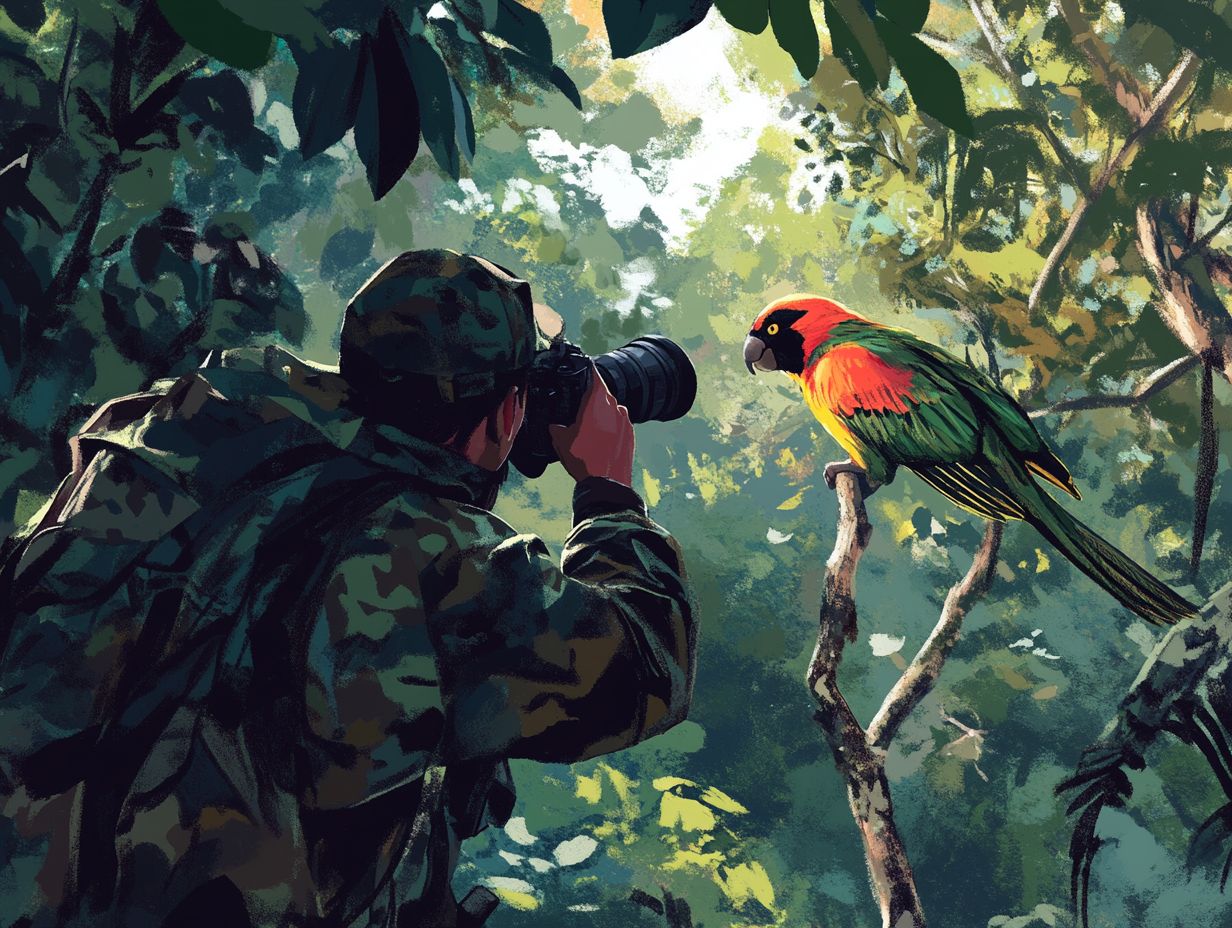
To take photos while bird watching, you need a camera, a telephoto lens, and a tripod. Set up your camera on the tripod, ensuring it is stable. Then, adjust your camera settings to a high shutter speed and continuous shooting mode. For those new to this hobby, you might want to learn more about what bird watching photography is before heading out. Finally, patiently wait for the perfect moment to capture the birds in action.
2. What type of camera is best for bird photography?
The best camera for bird photography is a DSLR with a telephoto lens. A DSLR allows you to adjust settings manually, while the telephoto lens enables close-up shots from a distance. For those interested in capturing the best moments, understanding the photography gear essentials for birdwatching is crucial. If you don’t have a DSLR, a point-and-shoot camera with a good zoom feature can also work well.
3. How can I get closer to birds for better photos?
Birds can be easily spooked, so approach them slowly and quietly. Use your surroundings to blend in and avoid sudden movements. You can also try using a natural blind or camouflage clothing to get closer to the birds without being noticed.
4. What is the best time of day to take photos while bird watching?
The best time of day to take photos while bird watching is during the golden hour, which is the first hour after sunrise or the last hour before sunset. The lighting during this time is soft and warm, creating stunning effects in your photos. For those using scopes, learning how to use bird watching scopes can enhance your experience, as birds tend to be more active at these times.
5. How do I capture birds in flight?
Capturing birds in flight can be challenging, but with practice, it yields amazing photos. Use a high shutter speed to freeze the bird’s movement and continuous shooting mode to capture multiple shots. Track the bird’s movement with your camera and anticipate its flight path.
Ready to take your bird photography to the next level? Practice responsible photography and engage with your local birding community!
6. Can I edit my bird photos?
Yes, you can edit your bird photos to enhance their quality! Remember to avoid changing the photo too much, so it still represents the bird accurately.
Use editing tools to adjust lighting, contrast, and color. Stay away from adding or removing elements from the image. The goal is to showcase the bird’s beauty in its natural habitat.

